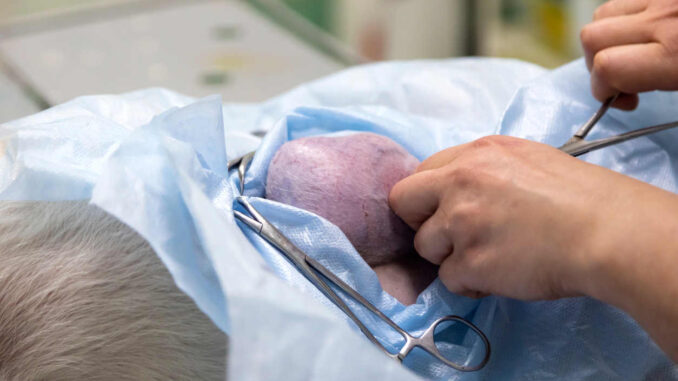
This article was updated on January 20th, 2024
✔️Article written by a veterinarian, and reviewed by Dr. Whittenburg, Pet Hospital Director.
Mammary tumors in female dogs are extremely common. So common that they make up around 40% of all diagnosed tumors in females (Intact, or unspayed, females have more than a one in four chance of developing mammary cancer in their lifetime. Dog mammary tumors are a big deal! So, it’s important to know how to recognize them early, what treatment looks like, and the prognosis for your pup.
In this article, we’ll focus on how mammary tumors in dogs are treated and just what that may end up costing you. There is great variation in the cost of removing dog mammary tumors. Depending on the size, number and type of tumor, you may pay $500-$3,000 or more. Let’s first look at treatment options before diving into the details of dog mammary cost removal costs.
How Are Dog Mammary Tumors Treated?
Whether a dog mammary tumor is benign or malignant, the most common treatment is surgical removal. All lumpy glands will need to be removed using a very wide margin of skin around the lump to ensure that the whole tumor is taken. Chemotherapy may also be used in more advanced cases where the cancer has spread to local lymph nodes or other areas of the body.
How Will the Vet Handle Dog Mammary Tumor Removal?
Diagnosis
Your vet will start with a thorough exam, including feeling the lump and checking for others, listening to the heart and lungs, and getting a history of when you noticed the lump and if it’s changed.
They will then try to get a fine needle aspirate of the lump using a small needle to suck out a sample. The sample can then be looked at under a microscope to see what types of cells are in there to determine tumor type. Bloodwork, x-rays, and ultrasound may also be done to see if the cancer has spread. Your vet may also sample the local lymph nodes to check for spread as well.
Treatment
Your vet is going to recommend that just about every dog mammary tumor be removed, even benign ones (even benign tumors can turn malignant). Surgical removal involves removing any affected glands, which can sometimes mean the entire mammary chain on one side. Spaying at the time of surgery may also be recommended to help reduce reoccurrence.
A wide margin will need to taken to be sure that entire tumor is removed. This means healthy skin on both sides of the tumor will be removed, leaving a potentially large incision. Incisions may need to be bandaged to protect them and keep them clean, antibiotics and pain meds will be prescribed as well.
If malignant tumors have spread, chemotherapy or radiation may also be recommended.
Costs of Removing Dog Mammary Tumors (By Surgery Type and Location)
The cost of treating dog mammary tumors is going to vary depending on the number and size of the tumors, and your location. For a single small tumor, costs may be as low as $500 for diagnostics and surgery. For larger or multiple tumors, that price is going to increase to $1,000-$3,000 or more. If chemotherapy is added, costs may be $1,000 or more.
| Cost | Small Town | Large City |
| 1 small tumor | ~$500 | $500-$800 |
| Multiple small tumors | $500-$1,000 | $800-$1,200 |
| 1 large tumor | $500-$1,200 | $800-$1,500 |
| Multiple large tumors | $1,000-$2,000 | $1,200-$2,500 |
Costs of Removing Dog Mammary Tumors (Specialists)
Surgeries performed by specialists may also cost more, as estimated in the table below:
| Surgery Type | Cost of Specialist |
| 1 small tumor | $1,500-$3,000 |
| Multiple small tumors | $1,500-$3,000 |
| 1 large tumor | $2,000-$5,000 |
| Multiple large tumors | $2,000-$5,000 |
Dog Mammary Tumor Removal Recovery
Surgery to remove a dog mammary tumor may leave your pup with a large incision and some discomfort. Your job is to make sure your pup stays quiet and doesn’t lick the incision. This may require an e-collar or soft wrap. You’ll want to monitor the incision daily to make sure there is no swelling, redness, oozing or foul odor.
Most incisions will heal in about two weeks without complications. It is recommended to keep dogs out of water until they are completely healed. Limit activity to prevent dogs from tearing out stitches or aggravating the incision.
Dog mammary tumors can reoccur, so it’s important to continue to check your dog for lumps and bumps and see your vet if you notice any new ones.
What You Should Know About Dog Mammary Tumors
Simply put, dog mammary tumors are tumors of the mammary glands in dogs. Females have five sets of mammary glands that extend from the armpit to the groin. For dogs that are spayed before their first heat, that mammary tissue is undeveloped, making it a much lower risk for mammary cancer. Females that remain intact or are spayed later in life have fully developed tissue and reproductive hormones that make them more susceptible.
Dog mammary tumors are benign about 50% of the time and malignant, or cancerous, about 50% of the time. They may be many different types and present as one singular tumor or multiple lumps that include more than one mammary gland. These lumps can be moveable under the skin or more tightly adhered to the underlying tissue.
Most mammary tumors in dogs start out as a small, firm lump. They may grow in size or spread to neighboring glands. If found early, most pups won’t show any other symptoms. However, if left untreated, these lumps can become ulcerated, bloody, or rupture. Dogs may also show lethargy, pain, difficulty breathing, and a decreased appetite.
Can Dog Mammary Tumors Go Away on Their Own?
Dog mammary tumors are not self-healing, meaning they don’t go away on their own.
When to Try At-Home Treatment for Dog Mammary Tumors
There is one case called mammary hyperplasia, where intact females will get lumps in their mammary glands during their heat cycle. The lumps go away once a dog goes out of heat. These lumps may show up once or twice a year, depending on how often your dog comes into heat.
If you notice mammary lumps on your intact female that also happens to be in heat, you may choose to wait and see if the lumps go away once she is out of heat. Otherwise, any new lump in the mammary glands should be seen by a vet as soon as possible.
When to Call Your Veterinarian
The prognosis for dog mammary tumors is always better the earlier the issue is caught. With this in mind, be sure to call your veterinarian when you first notice a new lump or bump on your dog’s belly. Most mammary tumors are found by dog owners during a belly rub or by the groomer during a routine clip or brushing.
Remember that dog mammary tumors can look very different depending on their type. They may be firm, smooth, bumpy, adhered, or moveable. There may be one or many that affect one gland or the whole mammary chain on one side.
Whether the lump is small, large, firm, or moveable, have your veterinarian take a look so that the proper diagnostics and treatment can start sooner rather than later. Your dog and vet will thank you!
Dog Mammary Tumor Removal FAQs with the Vet
Should My Dog’s Mammary Tumor Be Removed?
Even benign dog mammary tumors should be removed. This is because even small, non-cancerous lumps can grow, turn malignant, and spread. The best option to prevent this is removal when a tumor is small
How Long Can a Dog Live With a Malignant Mammary Tumor?
The life expectancy for dog mammary cancer is variable, depending on the type of tumor and if it’s spread or not. For severe cases, survival times may be as short as one month. Less severe cases may life up to two years. Survival time is increased with early detection, surgical removal if possible, and spaying.
Are Mammary Tumors Painful in Dogs?
Small, singular mammary tumors typically aren’t painful. Larger tumors may put some pressure on the abdomen, especially when a dog lies down. Mammary tumors may also become ulcerated or rupture, which can be painful.
Can an Older Dog Survive Mammary Tumor Removal Surgery?
There are many factors that a veterinarian will consider before a surgery. They will look at a dog’s overall health, including age. Bloodwork and an exam will be done to make sure a dog is healthy enough for anesthesia. Older dogs can survive surgery, especially if they are in good health otherwise.
How Long Does it Take Dogs to Recover from Mammary Tumor Removal Surgery?
For uncomplicated mammary tumor removals, most dogs will be fully recovered when the incision heals in about 10-14 days. More complicated or larger surgeries may require a little more time. For dogs that undergo chemotherapy or radiation following surgery, those times increase as well.
How Quickly Do Mammary Tumors Grow in Dogs?
Some types of mammary tumors can grow very quickly, doubling their size every month. Others may grow more slowly, seeming to not change in a year or more.
How Can I Tell if a Dog’s Mammary Tumor is Malignant?
Determining whether a mammary tumor is malignant nearly always requires a biopsy or histological diagnosis of the removed tumor. Often vets can’t tell just by looking at them or even with a fine needle aspirate.
What Should You Tell Your Vet Before the Visit?
You can help your vet out by knowing the history of your dog’s mammary tumor. Let them know when you first noticed it, if it’s changed, and any other signs they may be showing. Tell them if your dog is intact or at what age she was spayed.
Do mammary tumors only affect female dogs?
No, mammary tumors can also occur in males (though they are typically benign in male dogs in our experience).
Read more:
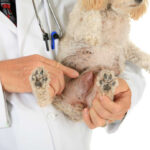 Life Expectancy & Survival Rate for Dogs with Mammary Tumors - Key insights: For benign tumors or malignant ones that haven’t yet spread, removal (without reoccurrence) is often curative. Benign tumors… [...]
Life Expectancy & Survival Rate for Dogs with Mammary Tumors - Key insights: For benign tumors or malignant ones that haven’t yet spread, removal (without reoccurrence) is often curative. Benign tumors… [...]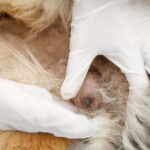 Rupture of a Dog Mammary Tumor: FAQ With a Veterinarian - Since dog mammary tumors make up more than 40% of all diagnosed tumors in dogs, it’s something that we deal… [...]
Rupture of a Dog Mammary Tumor: FAQ With a Veterinarian - Since dog mammary tumors make up more than 40% of all diagnosed tumors in dogs, it’s something that we deal… [...]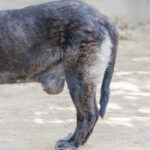 Dr. Bonk Explains Mammary Tumors in Dogs (With Pictures) - Not only are dogs capable of developing breast or mammary cancer, but they also do so at an alarming rate,… [...]
Dr. Bonk Explains Mammary Tumors in Dogs (With Pictures) - Not only are dogs capable of developing breast or mammary cancer, but they also do so at an alarming rate,… [...]Disclaimer: This website's content is not a substitute for veterinary care. Always consult with your veterinarian for healthcare decisions. Read More.


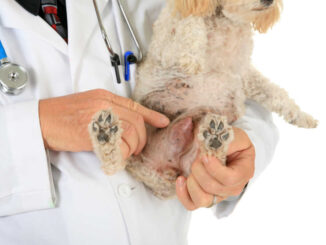
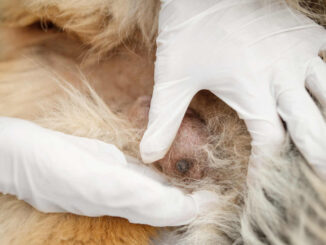
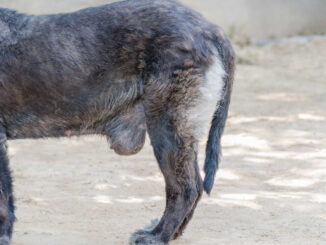
Be the first to comment